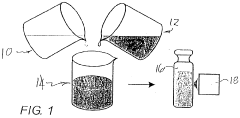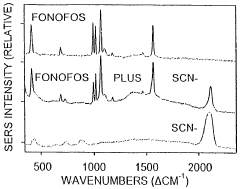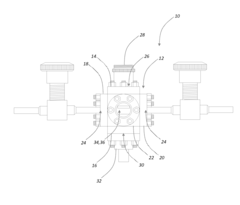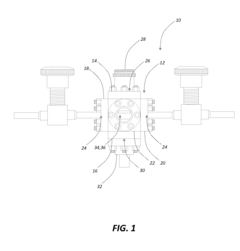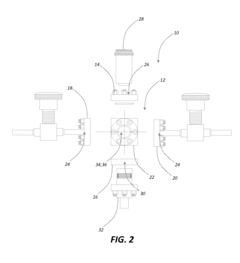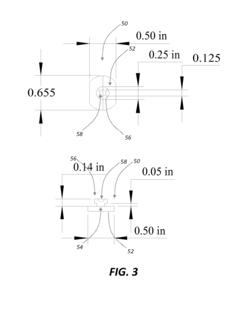Refining Raman Spectroscopy Under Varying Environmental Factors
SEP 19, 202510 MIN READ
Generate Your Research Report Instantly with AI Agent
Patsnap Eureka helps you evaluate technical feasibility & market potential.
Raman Spectroscopy Evolution and Objectives
Raman spectroscopy has evolved significantly since its discovery by C.V. Raman in 1928, transforming from a purely academic technique into a powerful analytical tool with diverse applications across multiple industries. The journey began with simple optical setups capable of detecting only the strongest Raman signals, progressing through several technological revolutions that dramatically enhanced its sensitivity, resolution, and applicability.
The 1960s marked a pivotal moment with the invention of lasers, providing the intense monochromatic light sources necessary for efficient Raman scattering. This advancement was followed by the development of holographic gratings and charge-coupled devices (CCDs) in the 1980s, which significantly improved spectral resolution and detection capabilities. The 1990s witnessed the miniaturization of components, leading to the first portable Raman systems.
Recent decades have seen remarkable progress in addressing the technique's traditional limitations. Surface-enhanced Raman spectroscopy (SERS) has pushed detection limits to single-molecule levels, while spatially offset Raman spectroscopy (SORS) has enabled analysis through opaque containers. Tip-enhanced Raman spectroscopy (TERS) has achieved nanoscale spatial resolution, opening new frontiers in materials characterization.
Despite these advances, environmental factors remain significant challenges for Raman spectroscopy applications. Temperature fluctuations, humidity variations, ambient lighting conditions, and sample fluorescence can all introduce artifacts or degrade signal quality. These environmental interferences are particularly problematic in field applications, industrial settings, and medical diagnostics where controlled laboratory conditions cannot be maintained.
The primary objective of refining Raman spectroscopy under varying environmental factors is to develop robust methodologies and technologies that maintain measurement accuracy and reliability regardless of external conditions. This includes creating advanced algorithms for background subtraction and signal processing, designing environmental compensation systems, and engineering more stable hardware configurations.
Secondary goals include expanding the technique's applicability in challenging environments such as extreme temperatures, high-pressure conditions, and high-humidity settings. There is also significant interest in developing real-time correction mechanisms that can dynamically adjust for changing environmental parameters during measurement.
The ultimate aim is to transform Raman spectroscopy from a predominantly laboratory-based technique into a universally deployable analytical tool that delivers consistent, high-quality spectral data across diverse environmental conditions. Success in this endeavor would dramatically expand the technique's utility in critical applications including environmental monitoring, food safety testing, pharmaceutical quality control, and point-of-care medical diagnostics.
The 1960s marked a pivotal moment with the invention of lasers, providing the intense monochromatic light sources necessary for efficient Raman scattering. This advancement was followed by the development of holographic gratings and charge-coupled devices (CCDs) in the 1980s, which significantly improved spectral resolution and detection capabilities. The 1990s witnessed the miniaturization of components, leading to the first portable Raman systems.
Recent decades have seen remarkable progress in addressing the technique's traditional limitations. Surface-enhanced Raman spectroscopy (SERS) has pushed detection limits to single-molecule levels, while spatially offset Raman spectroscopy (SORS) has enabled analysis through opaque containers. Tip-enhanced Raman spectroscopy (TERS) has achieved nanoscale spatial resolution, opening new frontiers in materials characterization.
Despite these advances, environmental factors remain significant challenges for Raman spectroscopy applications. Temperature fluctuations, humidity variations, ambient lighting conditions, and sample fluorescence can all introduce artifacts or degrade signal quality. These environmental interferences are particularly problematic in field applications, industrial settings, and medical diagnostics where controlled laboratory conditions cannot be maintained.
The primary objective of refining Raman spectroscopy under varying environmental factors is to develop robust methodologies and technologies that maintain measurement accuracy and reliability regardless of external conditions. This includes creating advanced algorithms for background subtraction and signal processing, designing environmental compensation systems, and engineering more stable hardware configurations.
Secondary goals include expanding the technique's applicability in challenging environments such as extreme temperatures, high-pressure conditions, and high-humidity settings. There is also significant interest in developing real-time correction mechanisms that can dynamically adjust for changing environmental parameters during measurement.
The ultimate aim is to transform Raman spectroscopy from a predominantly laboratory-based technique into a universally deployable analytical tool that delivers consistent, high-quality spectral data across diverse environmental conditions. Success in this endeavor would dramatically expand the technique's utility in critical applications including environmental monitoring, food safety testing, pharmaceutical quality control, and point-of-care medical diagnostics.
Market Applications and Demand Analysis
Raman spectroscopy has witnessed substantial market growth across diverse industries, with the global market valued at approximately 1.8 billion USD in 2022 and projected to reach 3.2 billion USD by 2028, representing a compound annual growth rate of 7.5%. This growth is primarily driven by increasing applications in pharmaceutical quality control, medical diagnostics, environmental monitoring, and advanced materials characterization.
The pharmaceutical and biotechnology sectors demonstrate the highest demand for refined Raman spectroscopy technologies that can operate reliably under varying environmental conditions. These industries require precise molecular identification capabilities for drug development, formulation analysis, and manufacturing quality control. The ability to perform non-destructive, real-time analysis while maintaining accuracy despite environmental fluctuations represents a critical market need, particularly as regulatory requirements for pharmaceutical manufacturing become increasingly stringent.
Environmental monitoring applications constitute another rapidly expanding market segment, with particular emphasis on water quality assessment, air pollution monitoring, and soil contamination analysis. Government agencies and environmental consulting firms seek portable Raman systems capable of delivering laboratory-grade results in field conditions where temperature, humidity, and ambient light vary significantly. The market increasingly demands solutions that incorporate automatic environmental compensation algorithms to ensure consistent results across diverse field conditions.
The materials science and semiconductor industries represent high-value market segments requiring ultra-precise Raman analysis under controlled environmental parameters. As nanomaterials and advanced composites become more prevalent in industrial applications, the need for characterization tools that can operate reliably under varying conditions has intensified. Market research indicates that companies are willing to invest significantly in systems that offer environmental stability features, with 65% of industrial users citing environmental interference as a major limitation of current technologies.
Healthcare applications present perhaps the most promising growth opportunity, with medical diagnostics increasingly incorporating Raman techniques for tissue analysis, disease detection, and surgical guidance. The clinical environment introduces unique challenges related to ambient lighting, temperature fluctuations, and biological sample variability. Market surveys indicate that medical institutions prioritize systems with robust environmental compensation capabilities, particularly for point-of-care applications where controlled laboratory conditions cannot be guaranteed.
Geographically, North America and Europe currently dominate market demand, accounting for approximately 60% of global revenue. However, the Asia-Pacific region is experiencing the fastest growth rate at 9.2% annually, driven by expanding research infrastructure and industrial applications in China, Japan, and South Korea. This regional diversification underscores the need for Raman systems capable of performing consistently across varying environmental conditions typical of different geographic locations.
The pharmaceutical and biotechnology sectors demonstrate the highest demand for refined Raman spectroscopy technologies that can operate reliably under varying environmental conditions. These industries require precise molecular identification capabilities for drug development, formulation analysis, and manufacturing quality control. The ability to perform non-destructive, real-time analysis while maintaining accuracy despite environmental fluctuations represents a critical market need, particularly as regulatory requirements for pharmaceutical manufacturing become increasingly stringent.
Environmental monitoring applications constitute another rapidly expanding market segment, with particular emphasis on water quality assessment, air pollution monitoring, and soil contamination analysis. Government agencies and environmental consulting firms seek portable Raman systems capable of delivering laboratory-grade results in field conditions where temperature, humidity, and ambient light vary significantly. The market increasingly demands solutions that incorporate automatic environmental compensation algorithms to ensure consistent results across diverse field conditions.
The materials science and semiconductor industries represent high-value market segments requiring ultra-precise Raman analysis under controlled environmental parameters. As nanomaterials and advanced composites become more prevalent in industrial applications, the need for characterization tools that can operate reliably under varying conditions has intensified. Market research indicates that companies are willing to invest significantly in systems that offer environmental stability features, with 65% of industrial users citing environmental interference as a major limitation of current technologies.
Healthcare applications present perhaps the most promising growth opportunity, with medical diagnostics increasingly incorporating Raman techniques for tissue analysis, disease detection, and surgical guidance. The clinical environment introduces unique challenges related to ambient lighting, temperature fluctuations, and biological sample variability. Market surveys indicate that medical institutions prioritize systems with robust environmental compensation capabilities, particularly for point-of-care applications where controlled laboratory conditions cannot be guaranteed.
Geographically, North America and Europe currently dominate market demand, accounting for approximately 60% of global revenue. However, the Asia-Pacific region is experiencing the fastest growth rate at 9.2% annually, driven by expanding research infrastructure and industrial applications in China, Japan, and South Korea. This regional diversification underscores the need for Raman systems capable of performing consistently across varying environmental conditions typical of different geographic locations.
Environmental Interference Challenges
Raman spectroscopy faces significant challenges when deployed in varying environmental conditions, which can substantially impact measurement accuracy and reliability. Temperature fluctuations represent one of the most critical environmental factors affecting spectral quality. As temperature increases, molecular vibrations intensify, leading to peak broadening and shifts in Raman spectra. Studies have shown that temperature variations as small as 5°C can cause detectable peak shifts in many organic compounds, potentially leading to misidentification or quantification errors.
Humidity presents another major interference factor, particularly for hygroscopic samples or when analyzing aqueous solutions. Water absorption can dilute sample concentration, while water vapor in the optical path may introduce additional spectral features. High humidity environments can also accelerate sample degradation during measurement, especially for biological specimens or unstable chemical compounds, resulting in time-dependent spectral changes that complicate data interpretation.
Ambient lighting conditions significantly impact signal-to-noise ratios in Raman measurements. Stray light from laboratory illumination, sunlight through windows, or nearby equipment can introduce background noise or even overwhelm the relatively weak Raman signals. This is particularly problematic when analyzing samples with low scattering cross-sections or when performing surface-enhanced Raman spectroscopy where precise detection of enhancement factors is crucial.
Atmospheric composition variations, including fluctuating CO2 levels, airborne particulates, and volatile organic compounds, can create interfering spectral features. Urban environments with higher pollution levels present particular challenges for open-path Raman systems or portable devices used in field applications. These atmospheric interferents can mask important spectral features or create false positives in automated detection systems.
Mechanical vibrations from nearby equipment, building vibrations, or transportation systems represent a significant challenge for high-resolution Raman measurements. Even minor vibrations can affect optical alignment, laser focusing, and ultimately spectral resolution. This becomes especially critical in industrial environments where heavy machinery operates nearby or in mobile applications where complete isolation from vibration sources is impractical.
Pressure variations, while less commonly discussed, can affect Raman measurements through changes in molecular packing and intermolecular distances. This is particularly relevant for crystalline materials, polymers, and measurements conducted at different altitudes or in pressurized environments. Pressure-induced phase transitions can dramatically alter Raman spectra, complicating comparative analyses across different measurement conditions.
Addressing these environmental interference challenges requires comprehensive understanding of their specific impacts on Raman spectroscopy and development of robust mitigation strategies tailored to particular application scenarios and sample types.
Humidity presents another major interference factor, particularly for hygroscopic samples or when analyzing aqueous solutions. Water absorption can dilute sample concentration, while water vapor in the optical path may introduce additional spectral features. High humidity environments can also accelerate sample degradation during measurement, especially for biological specimens or unstable chemical compounds, resulting in time-dependent spectral changes that complicate data interpretation.
Ambient lighting conditions significantly impact signal-to-noise ratios in Raman measurements. Stray light from laboratory illumination, sunlight through windows, or nearby equipment can introduce background noise or even overwhelm the relatively weak Raman signals. This is particularly problematic when analyzing samples with low scattering cross-sections or when performing surface-enhanced Raman spectroscopy where precise detection of enhancement factors is crucial.
Atmospheric composition variations, including fluctuating CO2 levels, airborne particulates, and volatile organic compounds, can create interfering spectral features. Urban environments with higher pollution levels present particular challenges for open-path Raman systems or portable devices used in field applications. These atmospheric interferents can mask important spectral features or create false positives in automated detection systems.
Mechanical vibrations from nearby equipment, building vibrations, or transportation systems represent a significant challenge for high-resolution Raman measurements. Even minor vibrations can affect optical alignment, laser focusing, and ultimately spectral resolution. This becomes especially critical in industrial environments where heavy machinery operates nearby or in mobile applications where complete isolation from vibration sources is impractical.
Pressure variations, while less commonly discussed, can affect Raman measurements through changes in molecular packing and intermolecular distances. This is particularly relevant for crystalline materials, polymers, and measurements conducted at different altitudes or in pressurized environments. Pressure-induced phase transitions can dramatically alter Raman spectra, complicating comparative analyses across different measurement conditions.
Addressing these environmental interference challenges requires comprehensive understanding of their specific impacts on Raman spectroscopy and development of robust mitigation strategies tailored to particular application scenarios and sample types.
Current Environmental Compensation Methods
01 Advanced Raman spectroscopy instrumentation
Modern Raman spectroscopy systems incorporate sophisticated optical components and detection systems to enhance measurement precision and sensitivity. These advancements include improved laser sources, specialized detectors, and refined optical pathways that minimize interference and maximize signal quality. Such instrumentation developments enable more accurate spectral analysis and better resolution of complex molecular structures, making Raman spectroscopy more effective for various analytical applications.- Advanced Raman spectroscopy instrumentation: Innovations in Raman spectroscopy hardware focus on improving sensitivity, resolution, and signal-to-noise ratio. These advancements include specialized optical components, detector technologies, and laser sources that enhance measurement precision. Modern instruments incorporate automated calibration systems and modular designs to accommodate various sample types and measurement conditions, enabling more accurate spectral data collection for complex analytical applications.
- Signal processing and data analysis techniques: Sophisticated algorithms and computational methods have been developed to refine Raman spectroscopy data. These techniques include baseline correction, noise reduction, peak deconvolution, and multivariate statistical analysis. Machine learning and artificial intelligence approaches are increasingly applied to extract meaningful information from complex spectral datasets, enabling automated pattern recognition and classification of spectral features with improved accuracy and efficiency.
- Sample preparation and measurement optimization: Methods for optimizing sample preparation and measurement conditions significantly enhance Raman spectroscopy results. These include techniques for reducing fluorescence interference, improving sample homogeneity, and controlling environmental factors that affect spectral quality. Specialized sample holders, substrate materials, and surface enhancement techniques (such as SERS) can dramatically increase signal intensity and measurement sensitivity for challenging analytes at low concentrations.
- Integration with complementary analytical techniques: Combining Raman spectroscopy with other analytical methods creates powerful hybrid approaches for comprehensive material characterization. These integrated systems may incorporate infrared spectroscopy, mass spectrometry, microscopy, or chromatographic techniques. Such combinations leverage the strengths of each method while compensating for individual limitations, providing multi-dimensional data that enables more complete analysis of complex samples and challenging materials.
- Application-specific Raman spectroscopy refinements: Tailored Raman spectroscopy solutions have been developed for specific industries and applications. These include specialized configurations for pharmaceutical quality control, biomedical diagnostics, environmental monitoring, and materials science. Application-specific refinements may involve customized sampling accessories, dedicated reference libraries, optimized measurement protocols, and specialized software interfaces designed to address the unique challenges and requirements of particular analytical contexts.
02 Signal processing and data analysis techniques
Sophisticated algorithms and computational methods have been developed to refine Raman spectroscopy data. These techniques include noise reduction, baseline correction, peak deconvolution, and multivariate statistical analysis. Advanced signal processing enhances the extraction of meaningful information from complex spectra, allowing for better discrimination between similar compounds and more accurate quantitative analysis. Machine learning approaches are increasingly being applied to automate spectral interpretation and improve analytical outcomes.Expand Specific Solutions03 Sample preparation and measurement methodologies
Refined approaches to sample handling and measurement protocols significantly impact the quality of Raman spectroscopic data. Innovations include specialized sample holders, controlled environmental conditions, and optimized measurement geometries. These methodologies address challenges such as fluorescence interference, sample heterogeneity, and thermal effects. Proper sample preparation techniques ensure more consistent and reliable spectral acquisition, particularly for complex biological samples or nanomaterials.Expand Specific Solutions04 Integration with complementary analytical techniques
Combining Raman spectroscopy with other analytical methods creates powerful hybrid approaches that overcome the limitations of individual techniques. These integrated systems may pair Raman with microscopy, mass spectrometry, or other spectroscopic methods. Such combinations provide multi-dimensional data that offers more comprehensive characterization of complex samples. The synergistic integration enhances analytical capabilities, enabling researchers to correlate molecular structure with other physical or chemical properties.Expand Specific Solutions05 Application-specific Raman spectroscopy refinements
Tailored Raman spectroscopy approaches have been developed for specific applications across various fields including pharmaceuticals, materials science, and biomedical diagnostics. These refinements may involve specialized sampling accessories, customized reference libraries, or application-specific calibration methods. By optimizing the technique for particular use cases, these developments enhance the practical utility of Raman spectroscopy in real-world scenarios, improving factors such as throughput, specificity, and ease of use.Expand Specific Solutions
Industry Leaders and Competitive Landscape
Raman spectroscopy technology is currently in a growth phase, with the market expected to reach significant expansion due to increasing applications across pharmaceutical, chemical, and security sectors. The competitive landscape features academic institutions like Tsinghua University and University of Washington conducting fundamental research, while commercial players demonstrate varying levels of technological maturity. Companies like ChemImage Corp. and Serstech AB offer specialized Raman solutions for security and forensics, while larger corporations including Siemens Healthineers and FUJIFILM integrate Raman capabilities into broader analytical portfolios. Environmental factor challenges are driving innovation, with NUCTECH and Intel developing more robust systems for field deployment. The technology is advancing toward greater miniaturization and environmental adaptability, with significant R&D investments from both specialized vendors and diversified technology conglomerates.
ChemImage Corp.
Technical Solution: ChemImage has pioneered the development of environmentally robust Raman spectroscopy through their Hyperspectral Raman Imaging (HRI) technology. Their approach combines traditional Raman spectroscopy with advanced imaging capabilities to create systems that can operate reliably in challenging environments. ChemImage's technology employs a multi-wavelength excitation approach that allows for selective enhancement of Raman signals while minimizing fluorescence interference that often varies with environmental conditions. Their systems incorporate automated background subtraction algorithms that continuously monitor and remove environmental noise patterns. For field applications, ChemImage has developed portable Raman devices with ruggedized housings that include internal environmental monitoring and compensation systems. These devices automatically adjust laser power, integration time, and signal processing parameters based on detected environmental variations. The company's VeriSpec® platform specifically addresses the challenges of varying humidity, temperature, and ambient light by employing a combination of hardware stabilization and software correction techniques. ChemImage has also developed specialized sample holders with controlled micro-environments for applications requiring extreme precision.
Strengths: Exceptional imaging capabilities combined with spectroscopic analysis provides more comprehensive data for environmental compensation; advanced algorithms effectively handle fluorescence interference that changes with environmental conditions; systems designed for both laboratory and field deployment. Weaknesses: Higher complexity in operation compared to standard Raman systems; image-based systems require more computational resources; some environmental compensation techniques may reduce throughput.
Serstech AB
Technical Solution: Serstech AB has developed innovative handheld Raman spectroscopy solutions specifically engineered to function reliably across diverse environmental conditions. Their Serstech Arx and Serstech A1 devices incorporate advanced environmental adaptation technologies that enable accurate substance identification regardless of ambient conditions. The systems employ a proprietary temperature-stabilized laser cavity design that maintains consistent wavelength output despite external temperature fluctuations, ensuring spectral precision in environments ranging from -20°C to +50°C. Serstech's devices feature automatic exposure control algorithms that dynamically adjust integration times based on ambient light conditions, allowing for reliable operation in both bright outdoor settings and dark indoor environments. Their ChemDash software platform includes environmental correction models that apply specific compensation factors based on detected environmental parameters. For humidity challenges, Serstech has implemented sealed optical pathways with specialized coatings that resist condensation and maintain optical clarity. The company's devices also incorporate vibration-dampening mechanisms that enable accurate measurements in unstable field conditions, making them particularly valuable for first responders and field researchers working in unpredictable environments.
Strengths: Exceptional portability combined with environmental robustness makes these systems ideal for field applications; intuitive user interface requires minimal training despite sophisticated environmental compensation; rapid analysis time (typically under 30 seconds) even with environmental correction algorithms. Weaknesses: Lower spectral resolution compared to laboratory-grade systems; limited laser wavelength options; battery life can be reduced when environmental compensation features are heavily utilized.
Key Patents in Environmental Correction Algorithms
Method for quantitative surface-enhanced raman spectroscopy using a chemical reference
PatentWO2005119218A2
Innovation
- A method involving a homogeneous test solution with a reference chemical of known concentration and a surface-enhanced Raman-active medium, where the intensities of characteristic spectral bands are measured to calculate the concentration of an analyte chemical, using a surface-enhanced Raman factor to correct for variations in enhancement ability.
Environmental cell assembly for use in for use in spectroscopy and microscopy applications
PatentActiveUS20140268124A1
Innovation
- An environmentally sealed cell assembly without conventional windows, allowing for vertical and rotational sample adjustment, evacuation, and gas introduction, with ports for lenses and gas management, ensuring direct optical communication between the sample and objective lenses without intervening structures.
Calibration Standards and Protocols
Calibration standards and protocols represent a critical foundation for ensuring the reliability and reproducibility of Raman spectroscopy measurements across varying environmental conditions. The establishment of standardized calibration procedures is essential for mitigating the effects of temperature fluctuations, humidity variations, and ambient light interference that can significantly impact spectral quality and data interpretation.
Industry-standard calibration materials such as silicon, polystyrene, and cyclohexane serve as primary reference standards due to their well-characterized Raman peaks and stability under different environmental conditions. These materials provide consistent spectral signatures that enable instrument performance verification and facilitate cross-laboratory comparisons. The National Institute of Standards and Technology (NIST) has developed certified reference materials specifically designed for Raman spectroscopy calibration, offering traceability and quality assurance for measurements.
Wavelength calibration protocols typically involve the acquisition of spectra from these reference materials before and after analytical measurements, allowing for the correction of spectral shifts induced by environmental factors. Temperature-dependent calibration curves have been developed for common reference materials, enabling more precise adjustments when operating in non-standard thermal environments. These calibration curves account for the thermal expansion effects on lattice vibrations that can alter peak positions.
Intensity calibration represents another crucial aspect of Raman spectroscopy standardization, particularly when quantitative analysis is required. Luminescence standards such as NIST SRM 2241 provide a means to normalize signal intensity across different instruments and environmental conditions. Multi-point calibration approaches that incorporate measurements at various temperatures and humidity levels have demonstrated superior performance compared to single-point calibrations when operating in fluctuating environments.
Automated calibration verification systems have emerged as valuable tools for maintaining measurement integrity during extended analytical sessions. These systems periodically measure reference standards and apply real-time corrections to compensate for environmental drift. Machine learning algorithms are increasingly being integrated into these systems to predict and adjust for environmental effects based on historical calibration data and current sensor readings.
International standardization bodies, including ASTM International and the International Organization for Standardization (ISO), have published comprehensive guidelines for Raman spectroscopy calibration. ASTM E1840 specifically addresses standard practices for Raman shift calibration, while ISO/TS 18621 provides guidance on measurement conditions and data reporting. Adherence to these standardized protocols facilitates global collaboration and ensures the comparability of results obtained under diverse environmental conditions.
Industry-standard calibration materials such as silicon, polystyrene, and cyclohexane serve as primary reference standards due to their well-characterized Raman peaks and stability under different environmental conditions. These materials provide consistent spectral signatures that enable instrument performance verification and facilitate cross-laboratory comparisons. The National Institute of Standards and Technology (NIST) has developed certified reference materials specifically designed for Raman spectroscopy calibration, offering traceability and quality assurance for measurements.
Wavelength calibration protocols typically involve the acquisition of spectra from these reference materials before and after analytical measurements, allowing for the correction of spectral shifts induced by environmental factors. Temperature-dependent calibration curves have been developed for common reference materials, enabling more precise adjustments when operating in non-standard thermal environments. These calibration curves account for the thermal expansion effects on lattice vibrations that can alter peak positions.
Intensity calibration represents another crucial aspect of Raman spectroscopy standardization, particularly when quantitative analysis is required. Luminescence standards such as NIST SRM 2241 provide a means to normalize signal intensity across different instruments and environmental conditions. Multi-point calibration approaches that incorporate measurements at various temperatures and humidity levels have demonstrated superior performance compared to single-point calibrations when operating in fluctuating environments.
Automated calibration verification systems have emerged as valuable tools for maintaining measurement integrity during extended analytical sessions. These systems periodically measure reference standards and apply real-time corrections to compensate for environmental drift. Machine learning algorithms are increasingly being integrated into these systems to predict and adjust for environmental effects based on historical calibration data and current sensor readings.
International standardization bodies, including ASTM International and the International Organization for Standardization (ISO), have published comprehensive guidelines for Raman spectroscopy calibration. ASTM E1840 specifically addresses standard practices for Raman shift calibration, while ISO/TS 18621 provides guidance on measurement conditions and data reporting. Adherence to these standardized protocols facilitates global collaboration and ensures the comparability of results obtained under diverse environmental conditions.
Miniaturization and Portability Trends
The miniaturization and portability of Raman spectroscopy systems represent a significant technological advancement that has expanded the application scope of this analytical technique. Traditional Raman spectrometers were bulky laboratory instruments, requiring controlled environments to function optimally. However, over the past decade, remarkable progress has been made in reducing the size, weight, and power requirements of these systems while maintaining analytical performance.
Recent developments in photonic integrated circuits and micro-electromechanical systems (MEMS) have enabled the creation of handheld Raman devices weighing less than 1 kg, compared to bench-top systems weighing 10-20 kg. These portable systems incorporate miniaturized lasers, spectrometers, and detectors that can operate under varying environmental conditions, addressing one of the key challenges in refining Raman spectroscopy for field applications.
The integration of complementary metal-oxide-semiconductor (CMOS) technology has further reduced the form factor of Raman systems. CMOS-based spectrometers on chips measuring just a few square millimeters have been developed, enabling integration into smartphones and other consumer devices. This miniaturization trend has been accompanied by advances in battery technology, allowing portable Raman devices to operate continuously for 8-12 hours in field conditions.
Environmental robustness has become a central focus in portable Raman system design. Modern handheld devices incorporate temperature compensation algorithms, vibration isolation mechanisms, and sealed optical paths to maintain spectral quality across varying humidity, temperature, and lighting conditions. These adaptations are crucial for applications in environmental monitoring, geological surveys, and industrial quality control where controlled laboratory conditions cannot be maintained.
Cloud connectivity represents another important trend in portable Raman technology. Miniaturized devices now commonly feature wireless capabilities that allow them to offload computational tasks to remote servers. This approach enables complex spectral analysis and reference database comparisons without requiring powerful onboard processors, further reducing device size and power consumption while enhancing analytical capabilities under challenging environmental conditions.
The commercial landscape reflects these technological advances, with several manufacturers now offering ruggedized handheld Raman systems specifically designed for operation in extreme environments. These devices incorporate IP67-rated enclosures, extended temperature operating ranges (-20°C to +50°C), and automated calibration routines that compensate for environmental variations, ensuring reliable spectral data acquisition regardless of field conditions.
Recent developments in photonic integrated circuits and micro-electromechanical systems (MEMS) have enabled the creation of handheld Raman devices weighing less than 1 kg, compared to bench-top systems weighing 10-20 kg. These portable systems incorporate miniaturized lasers, spectrometers, and detectors that can operate under varying environmental conditions, addressing one of the key challenges in refining Raman spectroscopy for field applications.
The integration of complementary metal-oxide-semiconductor (CMOS) technology has further reduced the form factor of Raman systems. CMOS-based spectrometers on chips measuring just a few square millimeters have been developed, enabling integration into smartphones and other consumer devices. This miniaturization trend has been accompanied by advances in battery technology, allowing portable Raman devices to operate continuously for 8-12 hours in field conditions.
Environmental robustness has become a central focus in portable Raman system design. Modern handheld devices incorporate temperature compensation algorithms, vibration isolation mechanisms, and sealed optical paths to maintain spectral quality across varying humidity, temperature, and lighting conditions. These adaptations are crucial for applications in environmental monitoring, geological surveys, and industrial quality control where controlled laboratory conditions cannot be maintained.
Cloud connectivity represents another important trend in portable Raman technology. Miniaturized devices now commonly feature wireless capabilities that allow them to offload computational tasks to remote servers. This approach enables complex spectral analysis and reference database comparisons without requiring powerful onboard processors, further reducing device size and power consumption while enhancing analytical capabilities under challenging environmental conditions.
The commercial landscape reflects these technological advances, with several manufacturers now offering ruggedized handheld Raman systems specifically designed for operation in extreme environments. These devices incorporate IP67-rated enclosures, extended temperature operating ranges (-20°C to +50°C), and automated calibration routines that compensate for environmental variations, ensuring reliable spectral data acquisition regardless of field conditions.
Unlock deeper insights with Patsnap Eureka Quick Research — get a full tech report to explore trends and direct your research. Try now!
Generate Your Research Report Instantly with AI Agent
Supercharge your innovation with Patsnap Eureka AI Agent Platform!

